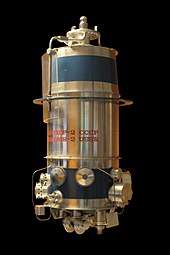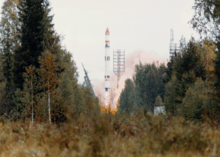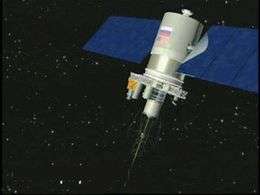Meteor (satellite)
The Meteor spacecraft are weather observation satellites launched by the Soviet Union and Russia. The Meteor satellite series was initially developed during the 1960s.[1][2] The Meteor satellites were designed to monitor atmospheric and sea-surface temperatures, humidity, radiation, sea ice conditions, snow-cover, and clouds.

Satellites
Meteor-1
Meteor 1-26 was considered to be the most likely candidate for a 7 January 2017 satellite near collision.[3] The Joint Space Operations Center which announced the possible collision didn't identify the satellites involved but third-party observers were of the opinion that Meteor 1-26 and DMSP F15 were the most likely candidates.[3]
- Meteor-1 launches
| Satellite | Launch date | NSSDC ID | SCN | Apogee, km | Perigee, km | Inclination | Period, min | Note |
|---|---|---|---|---|---|---|---|---|
| Kosmos 44 | 28 August 1964 | 1964-053A | 00876 | 857 | 615 | 65.04° | Technology demonstrator | |
| Kosmos 58 | 26 February 1965 | 1965-014A | 01907 | 647 | 563 | 65° | Technology demonstrator | |
| Kosmos 100 | 17 December 1965 | 1965-106A | 01843 | 658 | 630 | 65° | Technology demonstrator | |
| Kosmos 118 | 11 May 1966 | 1966-038A | 02168 | 657 | 587 | 65° | Technology demonstrator | |
| Kosmos 122 | 25 June 1966 | 1966-057A | 02254 | 683 | 657 | 65.14° | 97.12 | Technology demonstrator |
| Kosmos 144 | 28 February 1967 | 1967-018A | 02695 | 625 | 625 | 81.2° | 96.9 | |
| Kosmos 156 | 27 April 1967 | 1967-039A | 02762 | 630 | 630 | 81.2° | 97.0 | |
| Kosmos 184 | 24 October 1967 | 1967-102A | 03010 | 635 | 635 | 81.2° | 97.1 | |
| Kosmos 206 | 14 March 1968 | 1968-019A | 03150 | 630 | 630 | 81.2° | 97.0 | |
| Kosmos 226 | 12 June 1968 | 1968-049A | 03282 | 603 | 650 | 81.2° | 96.9 | |
| — | 1 February 1969 | — | — | — | — | — | — | Launch failure |
| Meteor-1 1 | 26 March 1969 | 1969-029A | 03835 | 644 | 713 | 81.2° | 97.9 | |
| Meteor-1 2 | 6 October 1969 | 1969-084A | 04119 | 630 | 690 | 81.2° | 97.7 | |
| Meteor-1 3 | 17 March 1970 | 1970-019A | 04349 | 555 | 643 | 81.2° | 96.4 | |
| Meteor-1 4 | 28 April 1970 | 1970-037A | 04393 | 637 | 736 | 81.2° | 98.1 | |
| Meteor-1 5 | 23 June 1970 | 1970-047A | 04419 | 863 | 906 | 81.2° | 102.0 | |
| Meteor-1 6 | 15 October 1970 | 1970-085A | 04583 | 633 | 674 | 81.2° | 97.5 | |
| Meteor-1 7 | 20 January 1971 | 1971-003A | 04849 | 630 | 767 | 81.2° | 97.6 | |
| Meteor-1 8 | 17 April 1971 | 1971-031A | 05142 | 620 | 646 | 81.2° | 97.2 | |
| Meteor-1 9 | 16 July 1971 | 1971-059A | 05327 | 618 | 650 | 81.2° | 97.3 | |
| Meteor-1 10 | 29 December 1971 | 1971-120A | 05731 | 880 | 905 | 81.2° | 102.7 | |
| Meteor-1 11 | 30 March 1972 | 1972-022A | 05917 | 878 | 903 | 81.2° | 102.6 | |
| Meteor-1 12 | 30 June 1972 | 1972-049A | 06079 | 897 | 929 | 81.2° | 103.0 | |
| Meteor-1 13 | 27 October 1972 | 1972-085A | 06256 | 893 | 904 | 81.2° | 102.6 | |
| Meteor-1 14 | 20 March 1973 | 1972-085A | 06392 | 882 | 903 | 81.2° | 102.6 | |
| Meteor-1 15 | 29 May 1973 | 1973-034A | 06659 | 867 | 909 | 81.2° | 102.5 | |
| Meteor-1 16 | 5 March 1974 | 1974-011A | 07209 | 853 | 906 | 81.2° | 102.2 | |
| Meteor-1 17 | 24 April 1974 | 1974-025A | 07274 | 877 | 907 | 81.2° | 102.6 | |
| Meteor-1 19 | 28 October 1974 | 1974-083A | 07490 | 855 | 917 | 81.2° | 102.5 | |
| Meteor-1 20 | 17 December 1974 | 1974-099A | 07574 | 861 | 910 | 81.2° | 102.4 | |
| Meteor-1 21 | 1 April 1975 | 1975-023A | 07714 | 877 | 906 | 81.2° | 102.6 | |
| Meteor-1 22 | 18 September 1975 | 1975-087A | 08293 | 867 | 918 | 81.2° | 102.3 | |
| Meteor-1 23 | 25 December 1975 | 1975-124A | 08519 | 857 | 913 | 81.2° | 102.4 | |
| Meteor-1 24 | 7 April 1976 | 1976-032A | 08799 | 863 | 906 | 81.2° | 102.3 | |
| Meteor-1 26 | 16 October 1976 | 1976-102A | 09481 | 871 | 904 | 81.3° | 102.5 | |
| Meteor-1 27 | 5 April 1977 | 1977-024A | 09903 | 869 | 909 | 81.3° | 102.5 | |
| References: [4][5][6] | ||||||||
Meteor-2
Meteor-2-21
Meteor-2-21/Fizeau is the twenty-first and last in the Meteor-2 series of Russian meteorological satellites, which were launched 22 times from 1975 to 1993.[7]
ILRS Mission Support Status: Satellite Laser Ranging (SLR) tracking support of this satellite was discontinued in October 1998. What makes Meteor-2-21 distinctive from the other meteorological satellites is its unique retroreflector array. Fizeau is named after a French physicist, Armand Fizeau, who in 1851 conducted an experiment which tested for the aether convection coefficient. SLR tracking of this satellite was used for precise orbit determination and the Fizeau experiment. The Fizeau experiment tests the theory of special relativity – that distance events that are simultaneous for one observer will not be simultaneous for an observer in motion relative to the first.
RetroReflector Array (RRA) Characteristics: The retro-reflector array consists of three corner cubes in a linear array with the two outer corner cubes pointing at 45 degree angles relative to the central cube. The central cube is made of fused silica and has a two-lobe Far Field Diffraction Pattern (FFDP) providing nearly equal intensities for compensated and uncompensated velocity aberration. Both outer reflectors have aluminum coating on the reflecting surfaces and near-diffraction-limited FFDPs. One of the end reflectors is made of fused silica with an index of refraction of 1.46 and should provide partial compensation of the velocity aberration. The other end reflector is made of fused glass with an index of refraction of 1.62 and should provide a perfect compensation of the velocity aberration.
SLR full-rate data from MOBLAS 4, MOBLAS 7, and Maidanak seem to confirm the presence of the compensating influence of the Fizeau effect. Resur-1, another Russian satellite launched in 1994, has 2 corner cubes reflectors with near diffraction-limited FFDPs, which were specifically designed for the continuation of this experiment. WESTPAC, a future SLR satellite, will verify indisputably the existence or otherwise of the Fizeau effect.
Instrumentation: Meteor-2-21/Fizeau had the following instrumentation on board:
- Scanning telephotometer
- Scanning infrared radiometers
- Radiation measurement complex
- Retroreflector array
Meteor-Priroda
- Meteor-Priroda launches
| Satellite | Launch date | NSSDC ID | SCN | Apogee, km | Perigee, km | Inclination | Period, min | Note |
|---|---|---|---|---|---|---|---|---|
| Use of Meteor-1 series platform | ||||||||
| Meteor-Priroda 1 (Meteor-1 18) | 9 July 1974 | 1974-052A | 07363 | 877 | 905 | 81.2° | 102.6 | |
| Meteor-Priroda 2-1 (Meteor-1 25) | 15 May 1976 | 1976-043A | 08845 | 866 | 900 | 81.2° | 102.4 | |
| Use of Meteor-2 series platform | ||||||||
| Meteor-Priroda 2-2 (Meteor-1 28) | 29 June 1977 | 1977-057A | 10113 | 602 | 685 | 98.0° | 97.5 | |
| Meteor-Priroda 2-3 (Meteor-1 29) | 25 January 1979 | 1979-005A | 11251 | 628 | 657 | 97.9° | 97.4 | |
| Meteor-Priroda 3-1 (Meteor-1 30) | 18 June 1980 | 1980-051A | 11848 | 589 | 678 | 97.9° | 97.3 | |
| Meteor-Priroda 2-4 (Meteor-1 31) | 10 July 1981 | 1981-065A | 12585 | 611 | 688 | 97.9° | 97.6 | |
| References: [8][5][6] | ||||||||
Meteor-3

The Meteor-3 series was launched 7 times between 1984 and 1994 after a difficult and protracted development program that began in 1972. All the satellites were launched on Tsyklon-3 rockets.[9] These satellites provide weather information including data on clouds, ice and snow cover, atmospheric radiation and humidity. The Meteor-3 class of satellites orbit in a higher altitude than the Meteor-2 class of satellites thus providing more complete coverage of the Earth's surface. The Meteor-3 has the same payload as the Meteor-2 but also includes an advanced scanning radiometer with better spectral and spatial resolution and a spectrometer for determining total ozone content. Meteorological data is transmitted to four primary sites in the former Soviet Union in conjunction with about 80 other smaller sites.
- Meteor-3 launches
| Satellite | s/n | Launch date | NSSDC ID | SCN | Apogee, km | Perigee, km | Inclination | Period, min | Note |
|---|---|---|---|---|---|---|---|---|---|
| Kosmos 1612 | 1 | 27 November 1984 | 1984-120A | 15406 | 130.2 | 1230.8 | 82.61° | 98.15 | launch failure, stage 3 failed to reignite |
| Meteor-3 1 | 2 | 24 October 1985 | 1985-100A | 16191 | 1236.0 | 1264.0 | 82.53° | 110.32 | |
| Meteor-3 2 | 3 | 26 July 1988 | 1988-064A | 19336 | 1198.2 | 1221.9 | 82.55° | 109.42 | |
| Meteor-3 3 | 4 | 25 October 1989 | 1989-086A | 20305 | 1191.0 | 1228.0 | 82.57° | 109.49 | |
| Meteor-3 4 | 6 | 24 April 1991 | 1991-030A | 21232 | 1190.0 | 1229.0 | 82.55° | 109.50 | |
| Meteor-3 5 | 5 | 15 August 1991 | 1991-056A | 21655 | 1199.7 | 1220.1 | 82.57° | 109.40 | |
| Meteor-3 6 | 7 | 25 January 1994 | 1994-003A | 22969 | 1191 | 1228 | 82° | 109.40 | |
| References: [10][11][9] | |||||||||
Meteor-3-5
Meteor-3-5, launched in 1991, is in a slightly higher orbit than Meteor-2-21, and operated until 1994. It transmitted on 137.300 MHz. Mechanically, it is similar to Meteor-2-21. Which satellite was in operation depended on the sun angles and consequently the seasons. Meteor-3-5 was usually the (Northern Hemisphere) "summer" satellite while 2-21 was in operation for approximately the half-year centered on winter. The satellite carried the second Total Ozone Mapping Spectrometer (TOMS) aloft as the first and the last American-built instrument to fly on a Soviet spacecraft. Launched from the Plesetsk, Russia, facility near the White Sea, on 15 August 1991, Meteor-3 TOMS had a unique orbit that presents special problems for processing data. Meteor-3 TOMS began returning data in August 1991 and stopped in December 1994.
Meteor-3-6/PRARE
The Meteor-3-6/PRARE satellite is the sixth in the Russian Meteor-3 series of meteorological satellites launched in 1994.
ILRS Mission Support Status: Satellite laser ranging and PRARE data was used for precision orbit determination and intercomparison of the two techniques. ILRS tracking support of this satellite was discontinued on 11 November 1995.
Instrumentation: Meteor-3-6 has the following instrumentation on board:
- Scanning TV-sensor
- Visible light and infrared radiometers
- Scanning infrared radiometer
- Ozone Mapper
- Precise Range and Range-Rate Equipment (PRARE)
- Retroreflector array
RetroReflector Array (RRA) Characteristics: The retro-reflector array is a box wing annulus with a diameter of 28 cm and has 24 corner cube reflectors.
Meteor-3M

The Meteor-3M series of satellites was to be an advanced series of polar orbiters with one 1.4 km resolution visible channel and a ten-channel radiometer with 3 km resolution. Initially four Meteor-3M satellites were planned, however due to financial difficulties only one was launched.[12]
Meteor-M
The first Meteor-M satellite, Meteor-M No.1, was launched 17 September 2009 16:55:07 UTC from Baikonur by a Soyuz-2-1b/Fregat rocket. Its mission ended in 2014.[13]
The second satellite, Meteor-M No.2 (also known as Meteor M2), was launched 8 July 2014 16:58:28 UTC from Baikonur by a Soyuz-2-1b/Fregat rocket. Its mission is scheduled to last 5 years.
On 27 November 2017, the launch of Meteor-M No.2-1 was lost after a programming error;[14][15] also lost were 18 smaller satellites from other nations.
On 5 July 2019, the replacement satellite for the failed Meteor-M No.2-1 satellite, the Meteor-M No.2-2 (also known as Meteor M2-2) was launched from Vostochny cosmodrome.[16]
On 18 December 2019, image downlink from Meteor-M No.2-2 ceased. Tracking revealed the craft had suffered degradation in orbit with a 2 km (1.2 mi) decrease in perigee. NORAD was not able to identify any space object involved in a collision. Roscosmos later confirmed that the satellite had suffered a decompression of its thermal control system following what is presumed to be a micrometeoroid impact. Following the incident, the spacecraft was automatically switched into a low-power mode and ground operators worked to restore the satellite's orbit and orientation. By 25 December 2019, the satellite had resumed controlled flight, but the future of its mission remains uncertain.[17][18]
Other Meteor-M satellites have been planned but their realization is uncertain.
See also
- Elektro–L, Russian geosynchronous meteorological satellites
References
- Soviet Weather Satellite Falls in Antarctica, RIA Novosti, 27 March 2012, accessed 28 March 2012
- Soviet Weather Satellite Falls in Antarctica, RIA Novosti on SpaceDaily.com, 28 March 2012
- "Update: High-Risk Satellite Conjunction passes without Incident". Spaceflight101. 7 January 2017. Retrieved 8 January 2017.
- "Meteor-1". space.skyrocket.de. Retrieved 4 April 2016.
- "Meteor - eoPortal Directory - Satellite Missions". directory.eoportal.org. Retrieved 5 April 2016.
- "П. А. Румянцев. Космическая система Метеор". epizodsspace.airbase.ru. Retrieved 4 April 2016.
- Meteor-2 Archived 11 October 2011 at the Wayback Machine, Encyclopedia Astronautica, accessed 17 September 2013
- "Meteor-Priroda". space.skyrocket.de. Retrieved 5 April 2016.
- "Meteor-3". www.astronautix.com. Archived from the original on 26 October 2010. Retrieved 19 April 2016.
- "Meteor-3 (17F45)". space.skyrocket.de. Retrieved 19 April 2016.
- "Космодром "Плесецк" | Информационный бюллетень №27". www.plesetzk.ru. Retrieved 19 April 2016.
- "Meteor satellite". www.russianspaceweb.com. Archived from the original on 10 April 2016. Retrieved 3 April 2016.
- https://www.russianspaceweb.com/meteor-m.html
- Russian satellite lost after being set to launch from the wrong spaceport: Deputy prime minister admits programmers gave the US$45 million device coordinates for Baikonur rather than Vostochny cosmodrome
- Soyuz 2-1B launch with Meteor-M ends in apparent Fregat-M failure
- http://russianspaceweb.com/meteor-m2-2.html
- "На Российском спутнике METEOR M2-2 произошла нештатная ситуация | R4UAB". r4uab.ru. Retrieved 23 December 2019.
- "О ситуации с КА «Метеор-М» № 2-2". roscosmos.ru. Retrieved 25 December 2019.
